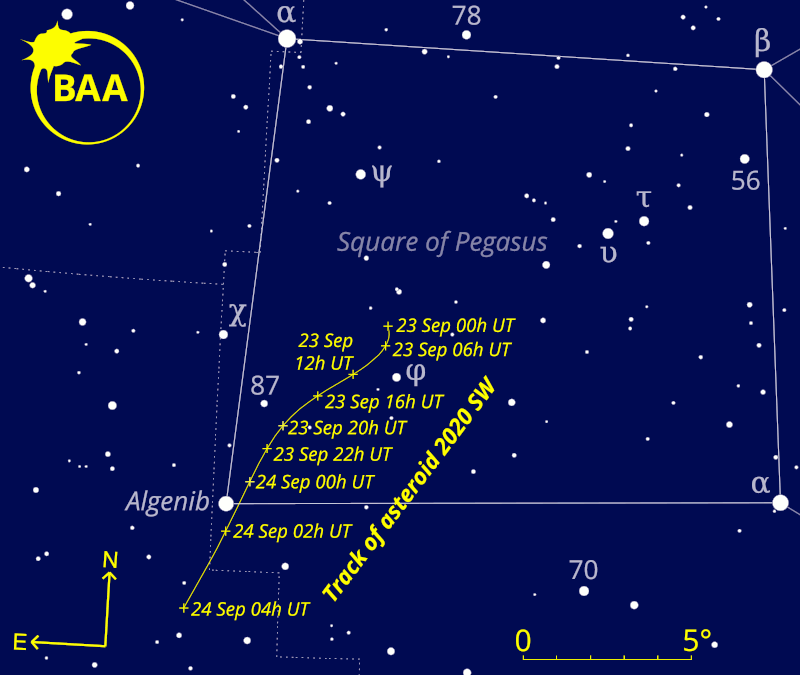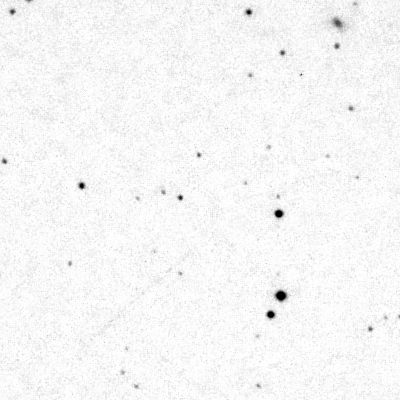2020 September 22
Asteroid 2020 SW making a very close pass of Earth on Sept. 24

Kacper Wierzchoś is both a professional astronomer by trade and an amateur by inclination as he enjoys recreational observing. It was whilst working with the 1.5-m Mount Lemmon Survey telescope on September 18 that he discovered a fast-moving object on a near-Earth trajectory, now designated 2020 SW. This object measures no more than about 10 metres across but it will approach to within about 28,090 ±20km (data from Bill Gray) from the centre of the Earth, i.e. well inside the region of space occupied by geo-stationary satellites. Note that its orbit is sufficiently well defined that there is zero possibility of it hitting our planet!

In the past few days its orbit has been refined thanks to follow-up observations by other professionals working with large telescopes but also by one amateur, Nick James who has already contributed two-night’s of astrometric measurements made using a 0.28-m Schmidt-Cassegrain instrument from Chelmsford. We now know closest approach will take place at 11:11 UT on September 24.
When to see it?
The night of September 23/24 will be the best time to observe this interloper, and seen from the UK it will be visible all night. It will be closer than the Moon from about 18:30 UT at a brightness of about magnitude 17.0V and moving at 20″/min rising in the eastern sky. It then accelerates and grows brighter as it moves across the sky past the meridian before heading towards the western horizon. It may be visible by eye using a 0.35-m or larger telescope reaching about 14.5V by about 04:45 UT when its speed will be some 2″/sec.
Use a sensitive CCD camera or videocamera on a telescope of at least 0.10-m aperture to image 2020 SW. Watch out for it varying in brightness as it tumbles through space – small objects such as this are often very elongated and spin quickly sometimes around two axes at the same time, i.e. tumbling.
Where to find it?
If you live in the British Isles, the topocentric ephemeris for the centre of the UK in the table below is a good first step. For other locations, go to the Minor Planet Center webpage and enter ‘2020 SW’. You will need to also enter an Observatory Code near you to avoid parallax errors in its position on the sky and the time you are planning to observe. The observatory code ‘967’ should suffice if you live in England.
Finder charts
In addition to the following ephemeris, we have two scaleable PDF finder charts suitable for viewing on a tablet/smartphone or for printing to use at the telescope. The Wide-Field Chart shows the constellation Pegasus with stars to magnitude +7, while the Narrow-Field Chart shows the region around Gamma Pegasi (Algenib) down to magnitude +16 at the time of 2020 SW’s closest approach shortly after 01:00 UT on September 24.
| Date | UTC | R.A. (J2000) Decl. | Delta | V.Mag | °/day |
| 2020 Sep 23 | 20:00 | 00h 06.6m +17°33′ | 0.0022 | +16.5 | 9.00 |
| 2020 Sep 23 | 20:30 | 00h 07.1m +17°24′ | 0.0021 | +16.5 | 9.41 |
| 2020 Sep 23 | 21:00 | 00h 07.6m +17°14′ | 0.0021 | +16.4 | 9.92 |
| 2020 Sep 23 | 21:30 | 00h 08.1m +17°03′ | 0.0020 | +16.3 | 10.55 |
| 2020 Sep 23 | 22:00 | 00h 08.5m +16°51′ | 0.0019 | +16.2 | 11.30 |
| 2020 Sep 23 | 22:30 | 00h 09.0m +16°37′ | 0.0018 | +16.1 | 12.20 |
| 2020 Sep 23 | 23:00 | 00h 09.5m +16°23′ | 0.0018 | +16.0 | 13.25 |
| 2020 Sep 23 | 23:30 | 00h 10.0m +16°07′ | 0.0017 | +15.9 | 14.47 |
| 2020 Sep 24 | 00:00 | 00h 10.6m +15°49′ | 0.0016 | +15.8 | 15.90 |
| 2020 Sep 24 | 00:30 | 00h 11.2m +15°30′ | 0.0016 | +15.7 | 17.55 |
| 2020 Sep 24 | 01:00 | 00h 11.8m +15°08′ | 0.0015 | +15.6 | 19.46 |
| 2020 Sep 24 | 01:30 | 00h 12.5m +14°45′ | 0.0014 | +15.5 | 21.68 |
| 2020 Sep 24 | 02:00 | 00h 13.3m +14°18′ | 0.0014 | +15.4 | 24.27 |
| 2020 Sep 24 | 02:30 | 00h 14.3m +13°48′ | 0.0013 | +15.2 | 27.30 |
| 2020 Sep 24 | 03:00 | 00h 15.4m +13°15′ | 0.0012 | +15.1 | 30.87 |
| 2020 Sep 24 | 03:30 | 00h 16.7m +12°37′ | 0.0011 | +15.0 | 35.10 |
| 2020 Sep 24 | 04:00 | 00h 18.1m +11°55′ | 0.0011 | +14.8 | 40.16 |
| This topocentric ephemeris of 2020 SW is computed for the centre of the British Isles (54°N, 2.5°W) on the dates and UTC (= BST -1 hour) shown. Its right ascension (R.A.) and declination (Dec.) are for the J2000.0 epoch; Delta is its distance from Earth in astronomical units; V.Mag is the predicted visual magnitude; °/day is the asteroid’s daily motion in degrees. Computation by Ade Ashford/Minor Planet Ephemeris Service/JPL’s HORIZONS system. | |||||
Good luck.
Richard Miles
Director, Asteroids and Remote Planets Section
| The British Astronomical Association supports amateur astronomers around the UK and the rest of the world. Find out more about the BAA or join us. |
